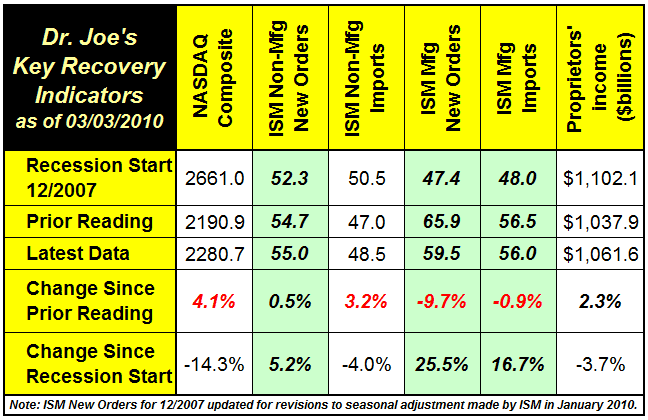The first full week of the month arrives with high expectations because of the importance of the economic data being released, notably the monthly unemployment report, but also the Institute for Supply Management (ISM) manufacturing and non-manufacturing reports. These are used in our recovery indicators which compare these data with the levels at which they were at the beginning of the recession.
These data do not tell us when the recession is over: it tells us when we have reached the pre-recession levels. The recession is, for all practical purposes, over. GDP is recovering, and some of the other indicators are stabilizing. A recession end does not means conditions are robust and booming, it just means that they stopped going down and have started to rise. The academicians and economists who have the responsibility for deciding the end of recessions do so in retrospect. They declared that this recession had started eleven months after that time. That is, the recession was eleven months old before they picked the date, December 2007, which made it the longest recession in recent times.

This month's recovery indicators, except for the NASDAQ stock index, which was up 4.1% since last month. The same three of our six indicators are above recession start levels as last month: ISM non-manufacturing orders, and manufacturing orders and imports. It must be noted that the non-manufacturing imports did go up by 3.2%, but this is a case of ?less bad,? because anytime an ISM index is below 50, it means that the index is contracting. At least it is contracting less.
New orders for manufacturing are still higher than recession-start levels, but fell by -9.7%. New orders are still rising, but at a lesser rate. This is probably related to the inventory replacement that made last quarter's GDP report so good at the top level, but caused great concern once the more granular data were reviewed.
Proprietors income, a measure of small business activity, went up +2.3% in the second of the GDP report revisions. We need to be careful with this, as tax planning might be part of the cause in 2010. Since these are the fourth quarter of 2009 data, we don't need to be concerned about this... yet. Such shifting of income and revenue to 2010 from 2011 to avoid the higher taxes of 2011 may add 1% to GDP levels once the year is complete. Some economists think the effect will be larger.
So our recovery indicators can actually be portrayed as slight deterioration, but let's just say we moved sideways... again.
This past Monday, Canada had a GDP report of the kind we're anxious to see. Strong growth, with a decline in inventories: what's not to like?. Canada has stood out in the global monetary crisis, and has even passed the U.S. in the important ranking of economic freedom. Canada's strong dollar does create a problem for those printers trying to sell in the U.S., but strong currencies are usually the result of greater demand for a nation's goods and services and respect for a careful monetary policy. Unfortunately, we may not have that experience on this side of the border for a few quarters to come.
In Monday's column we'll catch up on all of the other essential economic data, especially Friday's unemployment report, about which the White House seems to have started lowering expectations.














